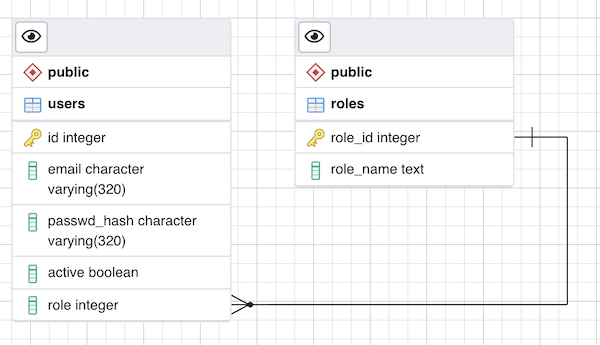

#Pgadmin 4 schema diagram password#
The password will be asked during the command execution. The following command will export the database database_name, from the host localhost with a user postgres and schema public to a file dump.sql. This can be done with the binary pg_dump. The first step is to make a dump of your PostgreSQL database. This process can be useful to make a backup of the database as a different schema name. The following steps are easy to follow and reproduce. This might sound like a trivial operation, but there's no built-in solution to perform this safely.
#Pgadmin 4 schema diagram how to#
In this post we'll learn how to duplicate a PostgreSQL schema. But first, we will see the syntax of creating a table in psql schema.Back to post list Duplicate a PostgreSQL schema 25-11-2019 Now, we will create a table in the psql schema, which we created above. And we can see that the Student table is created under the Table.And then click on Save to complete the process of creating a table as we can see in the below screenshot:.


Once we clicked on the table option, the Create-Table window will appear on the screen where we will enter all the necessary details like Table name.Now, we will right-click on the Tables option under the myschema, and where we will select the Create option from the given drop-down and then click on the Table as we can see in the below image:.Firstly, we are expanding the newly created schema myschema, and we can see the myschema contains the following:.And for this we are going to follow the below steps: Once we are done creating the schema in pgAdmin, we are going to create a table in the particular schema. In PostgreSQL, we can create a table in the schema in two different ways: Here we are going to create a table in the particular schema (which we created earlier in this section). After executing the above command, we can see the list of schema in the below screenshot:.Firstly, we will connect to the javatpoint database, and create a new schema as Jtp with the help of below command:.The myschema has been created once we clicked on the Save button, as shown in the below screenshot:.Once we clicked on the schema, the Create-schema window will appear on the screen where we will provide all the necessary details like Name, etc., and click on the Save.After that, for creating a schema, we will right-click on the Schemas option, and then select Create, and then click on schema option from the list.Once we expand the javatpoint database, we can see the Schemas.Now, we will expand the database javatpoint.And here, we are taking the first database, which is javatpoint. In the above image, we can see that there are two databases available in PostgreSQL.After that, we will expand the databases by clicking on the down-arrow icon, as shown in the below screenshot:.Firstly, open pgAdmin in our local system and connect PostgreSQL to the localhost server.We need to follow the below steps to create a schema: In this, we are going to create a schema in the latest version of pgAdmin. Note: To implement the create schema command, we should have the CREATE privileges in the existing database. If we are trying to create a new schema without using the IF NOT EXISTS option, which is already present, it will produce an error. This is an optional parameter, and it is used to create a new schema only if it does not occur. This parameter is used to describe the name of the schema, and the schema name should be exclusive in the existing database. We have the following parameters which are used in the above syntax: ParametersĬreate schema is a keyword, which is used to create a new schema in the database.


 0 kommentar(er)
0 kommentar(er)
